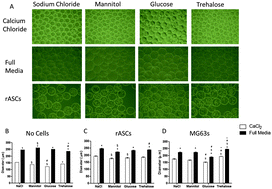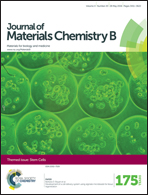Development of a cell delivery system using alginate microbeads for tissue regeneration
Abstract
Alginate microbeads incorporating adipose-derived stem cells (ASCs) have potential for delivering viable cells capable of facilitating tissue regeneration. These microbeads are formed in calcium crosslinking solutions containing organic osmolytes to ensure physiological osmolality, but the comparative effects of these osmolytes on the microencapsulated cells are not known. In addition, delivery parameters needed to use microencapsulated cells for tissue regeneration remain unknown. We investigated the following parameters: (1) osmolyte effects on microbead diameter, cell viability and growth factor production; (2) the effect of the number of cells per microbead and the number of microbeads per unit volume on cell viability, growth factor production, and microbead degradation; (3) the ability of both degradable and non-degradable alginate microbeads to localize cells at the delivery site in vivo; and (4) whether alginate microbeads containing alginate-lyase elicit an inflammatory response after repeated exposure. Smallest microbead diameters were achieved using glucose as the osmolyte but cell viability and growth factor production did not depend on osmolyte type. As cell number per microbead or microbead number per well increased, growth factor production per cell decreased although percent cell viability was unchanged. The rate of cell release varied with the number of beads per well and with the number of cells per microbead. At the highest microbead density and at the lowest density of cells per microbead, cell release was delayed. Therefore fewer microbeads may be sufficient for clinical applications. Both degradable (0.22 U g−1) and non-degradable (0 U g−1) alginate microbeads localized cells at the delivery site. Degradable alginate microbeads delivered subcutaneously elicited a mild chronic inflammatory response on second exposure, but how this might impact repeated use of the technology remains to be determined.

- This article is part of the themed collections: 2016 Journal of Materials Chemistry B Hot Papers and Stem Cells

 Please wait while we load your content...
Please wait while we load your content...